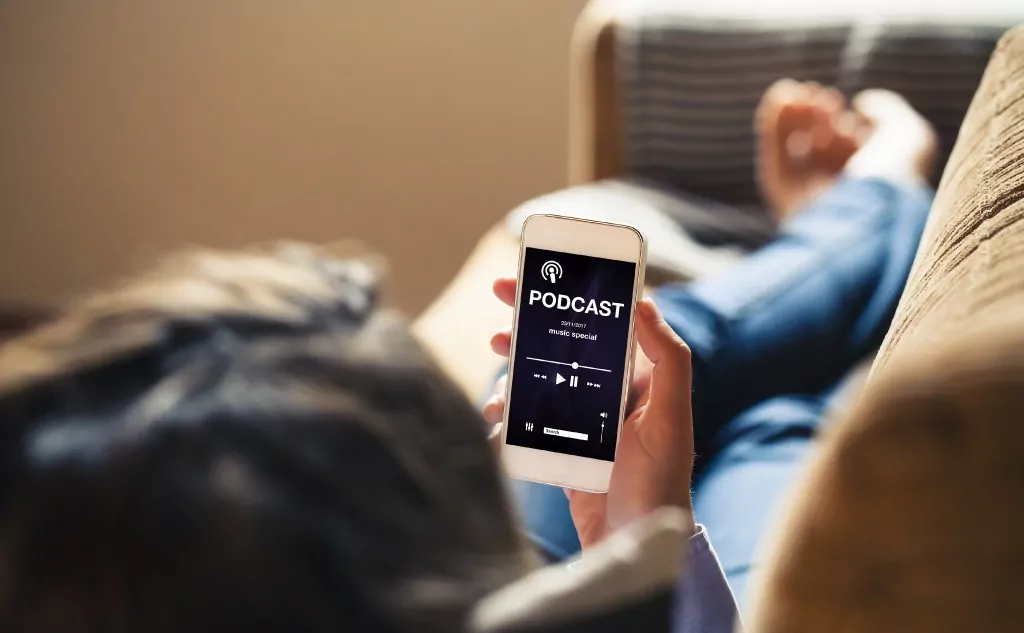Here’s how much data podcasts use:
In general, a podcast uses 1 MB per minute or 60 MB per hour.
It’s worth noting that the quality of the audio you’re listening to has an impact on your data usage.
Thus, if it’s a very high-quality audio podcast, then you’re going to consume your data plan in no time.
So if you want to learn all about podcast data usage, then you’re in the right place.
Let’s jump right in!
- Speechify: Safe to Use?
- Working From Home Data Usage: How Much?
- PlayStation Data Usage: How Much?
- Xbox Data Usage: How Much?
- How Much Data Does Eve Online Use?
- How much data does world of warcraft use? Find OUT!
- Snapchat Data Usage: How Much?
- WhatsApp Data Usage: How Much?
- Discord Data Usage: How Much?

How Did Podcasts Come About?
There’s a situation in which we’re driving or doing something at home, and we don’t want to listen to music.
Instead, we want to be productive, so maybe listening to something more informative would help us to achieve that goal.
So, we choose a different solution instead of listening to different radio channels, ads, promotions, and music.
Something that will open up new ideas, get us to think about things differently, or even shed some light on things we knew little about.
It’s never a bad time to listen to a podcast or two.
There are so many podcasts available out there.
We might even learn a couple of things by listening to them.
However, it might also affect our data plan.
Let’s first learn more about podcasts and the different podcast apps that are available out there.
Then we will see how much data we spend on them.
How Much Data Do Podcasts Use in General?
It’s only natural that everything you use online consumes some part of your data plan.
Your bandwidth suffers more than ever as everything slowly migrates to the online environment.
The fortunate thing is that you still do most of the stuff locally.
When we speak about locally, we mean on our devices and their local storage.
So, there are a couple of things you need to know about podcasts and data usage.
First, the quality of the audio you’re listening to has a huge impact on your data usage, period.
If it’s a very high-quality audio podcast, then you’re going to fry your data plan.
Fortunately, you can always regulate this.
Some podcast apps come with an option to set the quality of the podcast, meaning that you can stream it at a lower quality and consume less data.
However, if this doesn’t work, then you need to do something different.
Streaming vs. Downloading Podcasts Data Usage
When you stream a podcast, your device consumes data as it would with any other streaming service or app that uses data.
Imagine surfing Facebook.
If you spend one hour looking at funny videos or browsing fake news on Facebook, you’ll spend nearly 120 MB (Megabytes).
Seriously, this means 3.6 GB (Gigabytes) a month.
Take into account that Facebook is not the only thing you use on your phones.
There are countless other apps that consume data.
And when you stream something, you continually download the file and erase it at the same time.
When you want to go back and relisten to something you didn’t pay attention to, you go back, but you have to load that part again, and this will take data from you.
But, with downloading, it’s quite different. You have the file stored locally.
However, there’s an amazing option you can use in podcasting apps called the Auto Downloading feature.
This feature makes the podcasts you subscribe to appear on your phones without spending a huge amount of data.
If you’re using Google Podcasts, open the app, tap on your profile in the upper right corner, and tap on Podcasts settings.
Once there, you can see the Auto Downloading feature. Tap on that as well.
You can now toggle Auto Download New Episodes, and another option immediately appears to you.
If you are only on Wi-Fi, make sure to toggle this as well to turn it on.
This means that your new episodes of podcasts that you like will download in the background when you’re connected to Wi-Fi.
It’s easy to do the same thing with Apple Podcasts. Just take your iPhone, and go to Settings > Podcasts > Download Episodes.
Once you get there, you can only turn the option off or select Only New.
Although Only New is a decent solution, it can still consume a lot of data, especially if you’re subscribed to numerous podcasters.
This is why there are many reports that podcasts use over 500 MB an hour.
Fortunately for you, this might not be the case at all.
When you stream podcasts on your phones, the amount of data you use is approximately 1 MB a minute, which means that Podcasts consume about 60 MB an hour.
What Is a Podcast?

Podcasts are like TV shows.
The only difference is that there’s no video. When we watch TV shows, the whole picture is painted, literally. For podcasts, we only get the audio.
Just like TV shows, podcasts are organized by episodes.
They’re like a series that we can download and listen to. We can also stream podcasts.
There are a lot of apps that provide this service.
A couple of great things about podcasts include that they are often free to listen to, and anyone can make a podcast.
You can do it, too. It’s similar to becoming a YouTuber.
Just record a couple of opinions that you might have on some current events or topics or record a discussion with authority on a certain topic, and voila, you’ve become a podcaster.
By making a feed, you can make your own podcast.
These feeds work through RSS (Really Simple Syndication). It’s like a quick access address.
When you subscribe to an RSS feed, you get updates on it immediately.
So, that’s why it’s used for podcasts.
We install a podcast player, and we subscribe to a couple of podcasters.
The next thing you know, we’re getting their episodes downloaded automatically every time they post something new online.
This is how a podcasting feed works, but we’ll explore that topic later.
First, let’s learn more about the types of podcasts out there.
There are several types of podcasts:
- Live podcasts: As the name states, these are somewhat live podcasts. Actually, they’re just recorded in front of a live audience. Also, there can be an event similar to a concert that isn’t part of the actual feed. It’s just a backdrop.
- Podcast audiobooks: Imagine having the Lord of the Rings read to you chapter-by-chapter every night before you go to sleep. Well, this is what it’s all about. The book gets divided into several parts and narrated.
Some podcasts even include different sound effects to provide a more immersive experience. It can really be amazing.
- Slidecasts: For these, we have some visuals included. It’s basically like narrating a slideshow. We prepare our quarterly report in slide format. We start speaking about it and change slides to progress to the next topic. This is that kind of podcast.
- Fiction podcasts: These are radio plays, dramas, or something you might hear at a theater where the actors on set are actually behind the curtain or you’re blindfolded. This is how these actually work, but they’re pretty cool.
- Video podcasts: It’s just like a regular podcast, only with video content. The difference between a video podcast and a regular video you can find on YouTube or Facebook is that video podcasts have very formal and informative content.
Podcast Apps
As we already said, there are so many apps out there.
When we can choose between 13 different home workout apps or 5 different financial trackers, we can choose between several podcasting apps.
We have the mainstream Apple Podcasts and Google Podcasts.
However, there are many others.
Here are a few examples: Podcast Addict, Spotify, iCatcher, Castbox, and Pocket Casts.
Most of these work on both the Android and the iOS platforms.
And, depending on the device you own, and if you’re a podcast subscriber, you probably have either Podcasts or Google Podcasts.
If you’re a podcaster, you might have both, congrats! If this is the case, we believe that it’s great that you’re getting your ideas and opinions out there.
Podcasts Apple
Apple’s Podcasts app was released in 2012.
However, we encountered it before as part of the iTunes app.
It was just a section on the app. Now it’s much more than that.
We can upload our podcasts if we’re a podcaster, and we can listen to several different audio shows on the Podcasts app.
There are even guidelines for Apple Podcasts if you’re a podcaster.
Apple offers insights about your podcasts with its analytics.
Google Podcasts
It’s an Android equivalent of the Podcasts app on iOS.
It was officially released in 2018 for Android devices.
Google Podcasts has the added benefit of having an iOS version, and it works on Windows. So you will have lots of options.
Both of these apps work quite similarly, and there’s no need to go on about what they offer. If we want to listen to something interesting, we simply subscribe.
We have to make sure that we find something we like.
Otherwise, it might be very boring, and we might rush into uninstalling the app. There’s no need for that. Give it a chance.

